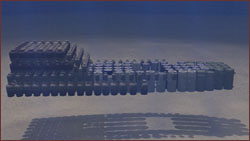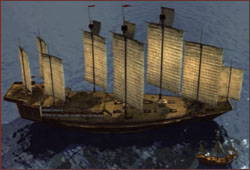 |
 |
Asia's Undersea Archeology
Part 2 | Back to Part 1
Evidence from South Korea
How typical or representative was the Quanzhou ship of Asian ships of its time?
While the process of archeological comparison has only begun and will require
more data, additional information is available from two important shipwreck
sites in South Korea.
From 1976 to 1982, archeologists excavated a rich cargo from a submerged wreck
near Shinan, and this initial work was followed by excavation and recovery of
the ship's remaining structure. These remains are now undergoing conservation
treatment at the Mokpo Conservation and Restoration Center of South Korea's
Cultural Properties Research Institute, and a one-fifth-scale model has been
built at the Mokpo Center to aid in the analysis of the ship's structure.
Experts dated the shipwreck to 1323 using an associated wooden cargo tag and
coins, the latest of which were minted in 1310 and may be of South Chinese
origin.
So far, this ship's cargo has attracted the most attention. The cargo included
at least 16,000 ceramic items and over seven million brass-bronze coins
(totaling over 26 tons). These coins provided a dramatic example of recycling
and reuse in the archeological record, since the oldest coin in this collection
dated to A.D. 14.
|  As this
animation of the Brunei wreck shows, careful mapping of a shipwreck can provide
archeologists with an understanding of where cargo was stored in a ship before
it sank.
As this
animation of the Brunei wreck shows, careful mapping of a shipwreck can provide
archeologists with an understanding of where cargo was stored in a ship before
it sank.
View the clip in:
QuickTime |
RealVideo:
dialup |
broadband
Get video software:
QuickTime |
RealPlayer
|
Archeologists recovered a similarly impressive priority cargo from the other
major early shipwreck in South Korea—the Wando ship, discovered in 1984.
This vessel held a cargo of at least 30,000 pieces of celadon ceramics, which
have been traced to a kiln in Haenam Province and probably date to A.D.
1050-1100.
Taken together and in comparison with the Pattaya wreck from Thailand (an early
planked vessel with structural similarities to the Quanzhou ship), these ships
show evidence of considerable diversity in shipbuilding methods, even when
cultural links with China were strong. The Quanzhou, Shinan, and Pattaya ships
all had V-shaped hulls with keels, and transverse bulkheads were one of the
most distinctive elements of this shipbuilding tradition. The isolation
attributed to this tradition may be more apparent than real, since even the
limited archeological evidence available so far reveals a series of wrecks that
were historically linked by eclectic building methods that overlapped over a
wide geographical area extending at least from Thailand to Korea.
As for its isolation from medieval European shipbuilding cultures, we see
striking differences—most notably in the use of transverse bulkheads about
500 years before European shipbuilders widely adopted the practice in their
ships—that are not surprising given the distances involved and the barrier
that Islamic conquest of the intervening territory created. What is especially
interesting is the parallel Asian use of certain techniques that appeared at
various times in early European shipbuilding, such as the
keel-and-V-shaped-hull combination, in-line masts, and mortise-and-tenon
joinery (in the case of the Wando ship). Rather than being due to any sort of
direct historical contact between Europe and East Asia at that time, one might
more easily interpret these parallelisms as the product of convergent
technological responses to similar circumstances by shipbuilders whose levels
of skill and craft knowledge were also similar.
 China's so-called "treasure junks" greatly outsized European ships
of the day. But did they really exist?
China's so-called "treasure junks" greatly outsized European ships
of the day. But did they really exist?
|
|
Treasure ships a myth?
Nothing in the archeological record so far provides direct evidence for anything like
the Ming Dynasty's treasure ships, and one must apply the same empirical
skepticism normally used in evaluating archeological claims to accounts of
these ships. Did nine-masted ships over 400 feet long really accomplish these
fabled voyages? The possibility has fascinated Chinese scholars and has
resulted in the construction of a hypothetical model of such a ship in 1985 at
the Zheng He Research Institute in Nanjing. Literary sources suggest that the
treasure ships combined the characteristics of the fuchuan, a
multimasted seagoing type of vessel with a keel, V-shaped hull, multiple decks,
and elevated bow and stern (for greater height in fighting, similar to the
northern European cogs adapted for fighting); and a type of shallow-water boat
with a flat bottom and squared-off prow called the shachuan. The
Quanzhou ship could be the remains of a fuchuan-type vessel, comparable
in size and general character to the largest contemporary medieval European
cogs and carracks but nowhere near as large as the treasure ships
described.
Estimates of the treasure ships' size are based in literary references in texts
pertaining to the first of the Ming emperors, Zhu Di (1402-1424). Zhu Di was
known for grandiose projects such as the monumental tomb he built for his
father; a stone tablet intended for this tomb was so large that workers could
not move it from its quarry at Nanjing to the tomb site. Ship construction and
overseas trading expeditions on a grand scale would have been consistent with
Zhu Di's known behavior. The calculations were based on units of measurement
used in shipbuilding during the Ming period, which, if correctly understood,
described ships of about 400 feet long by 150 feet wide.
If correct, these dimensions record by far the largest wooden ships ever built.
Even the biggest of the 5,000-6,000-ton wooden battleships of the mid- to late
19th century and the 5,000-ton wooden motorships constructed in the
United States during World War I did not exceed 340 feet in length or 60 feet
in width. The longest of these ships, the Mersey-class frigates, were
unsuccessful, and one, HMS Orlando, showed signs of structural failure
after an 1863 voyage to the United States. The Orlando was scrapped in
1871 and the Mersey soon after. Both the Mersey-class frigates and the
largest of the wooden battleships, the 121-gun Victoria class, required
internal iron strapping to support the hull, as did many other ships of this
kind. In short, the construction and use histories of these ships indicated
that they were already pushing or had exceeded the practical limits for the
size of wooden ships.
|  Did Ming shipbuilders
succeed in constructing ships 40 percent longer and 65 percent wider than any
known wooden vessel? Further discoveries by maritime archeologists may hold the
answer.
Did Ming shipbuilders
succeed in constructing ships 40 percent longer and 65 percent wider than any
known wooden vessel? Further discoveries by maritime archeologists may hold the
answer.
|
How did the Chinese shipbuilders construct and operate wooden ships that were
40 percent longer and 65 percent wider than the largest wooden ships known to
have been built at any time anywhere else? Since no special construction
techniques such as iron strapping for supporting the wooden hulls of these
treasure ships were reported, there is something inherently improbable about
the claims made for them in the Ming texts. Perhaps these texts only describe a
grandiose dream and the overseas trading voyages of the early Ming Dynasty
were, in fact, accomplished with large numbers of smaller ships. Or perhaps one
or more ships of this kind were built at the Longjiang shipyard outside Nanjing
but never sailed.
As with the tomb slab for his father, Zhu Di's ambitions may have outstripped
reality. More convincing documents or direct archeological evidence will be
needed to demonstrate that his treasure ships ever operated as claimed.
Although maritime archeology in East Asia does not yet support extreme claims
for the grandeur of the medieval Chinese shipbuilding, it does reveal an
energetic and varied maritime cultural tradition that flourished until it was
abruptly cut off in the Ming Dynasty. It will be especially important now for
archeologists to see just how effective and complete the Ming ban on oceangoing
commerce was after A.D. 1550.
 |
|
Dr. Richard Gould is Professor of
Archeology at Brown University and a leading expert on underwater archeology,
who has studied shipwrecks in Bermuda and the Dry Tortugas. He is the
author of ten books, including Archeology and the Social History of Ships
(Cambridge University Press, 2000), from which this article was adapted with permission. |
Photos: (1,3,4) Courtesy of Gedeon Communications; (2,5,6) Pierre Corrade.
On China's China |
Ancient Chinese Explorers
Asia's Undersea Archeology |
Date the Dish |
Resources
Transcript |
Site Map |
Sultan's Lost Treasure Home
Editor's Picks |
Previous Sites |
Join Us/E-mail |
TV/Web Schedule
About NOVA |
Teachers |
Site Map |
Shop |
Jobs |
Search |
To print
PBS Online |
NOVA Online |
WGBH
© | Updated January 2001
|
|
|